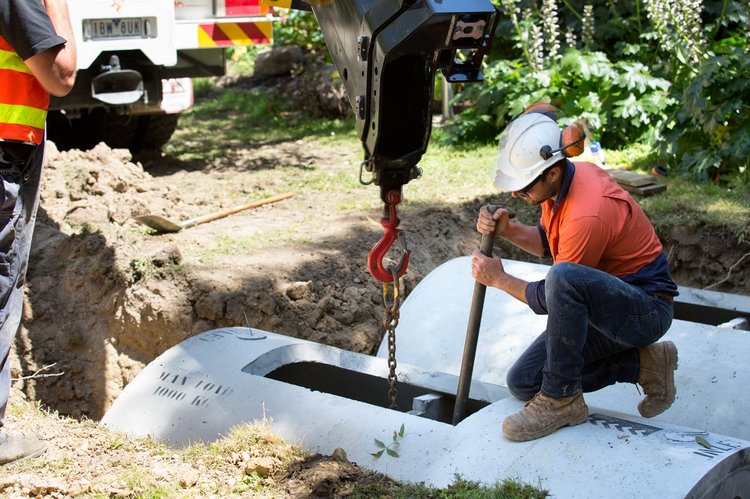The variety of wastewater treatment systems at your fingertips may feel slightly daunting. Not only are there different types of septic systems, but there are many different manufacturers in the marketplace as well. Fortunately, deciding between one and the other is fairly simple, and we here at SSA will happily help you out if you find yourself stuck in the mud.
To start, here we’re going to talk about the differences between these two kinds of systems, and which one is right for you. depending on the location, and type of land you’re installing it on.
Primary Waste Treatment Systems
When we talk about a “primary” system, what we really mean is a conventional septic tank with an absorption trench and no other supplementary systems. The effluent flows from the house into the Septic Tank via gravity, and then to the trenches via gravity (or if gravity can’t be achieved, then in some cases it is pumped). The effluent is distributed along the length of the trench through pipes with holes in them. Trenches are filled with gravel and sand, which helps to filter out the pathogens, toxins and other contaminants before it disperses through the soil. Vegetation (typically grass) is planted on top of trenches to allow the take up of nutrients and to help remove excess water through evapotranspiration. Absorption trenches are excavated underground so that the effluent doesn’t come into contact with humans and animals because the quality of the effluent is generally poor.
Generally, ‘primary’ septic systems are not allowed to be used on: blocks smaller than two acres; in environmentally sensitive areas (especially near waterways that lead to potable drinking reserves) or on commercial premises due to the poor quality of the final effluent. And sadly, you won’t be able to use the effluent to water your gardens and lawns.
However, these systems can be cost-effective to install and have ongoing low maintenance. And, if your land has a significant slope to it and you can achieve gravity, you may be able to install the septic tank and trenches without an electrical pump, which can save on power too. This is why many landowners choose to go with a simple primary system – it’s cheaper, it’s easy to look after, and you don’t have to worry about it for years at a time.
Secondary Waste Treatment Systems
‘Secondary Treatment’ septic systems like Aerated Wastewater Treatment Systems (AWTS) and sand filter septic systems treat the wastewater from your home to a much higher quality, before the water can be dispersed to your land and used to water your gardens and lawns. Many people prefer these systems because they are environmentally beneficial and contribute water back to the earth, while reducing the risk of contamination on your land and of local waterways.
SAND FILTER SEPTIC SYSTEM
Much like a primary system, this kind of system should only be used on larger sites because you need more room to fit in all the components: a Septic Tank, a Sand Filter, a Pumpwell or Final Chamber and either absorption trenches or subsurface irrigation. However, the final quality of the effluent is excellent in comparison. One of the biggest benefits is that if you can achieve gravity all the way from your house through to the irrigation field, then you can reduce any reliance on pumps, which produces a really low maintenance system.
If you choose this kind of system, be prepared to shell out a few more dollars during the installation, and most importantly, make sure this system is well cared for, because they can be very expensive to replace, once the sand filter has failed! And keep in mind that these systems really don’t like rocky, sandy or steep sites or properties in high water table areas. But if none of this applies to you, these systems are low maintenance and great for the local environment.
AERATED WASTEWATER TREATMENT SYSTEM (AWTS)
An Aerated Wastewater Treatment System (AWTS) is the most versatile installation type as it can be used on all types of properties, including steep, rocky or sandy, or sites with limited space or high water table areas, and even commercial premises. With regular maintenance and care, these systems will last a long while, and, like the Sand Filter, you’re able to use the final effluent to water your grass and plants, via any irrigation type, but most typically subsurface irrigation.
Keep in mind that you have to have the system serviced quarterly, as it is mechanical and therefore has a lot of moving parts. They also require a continuous power supply. However, for the versatility they offer, it’s unsurprising that many landowners opt for an AWTS.
There are many different brands of AWTS available on the market, which can lead to a lot of confusion. But you can have peace of mind that any system that has tested against the Australian Standards and has a current Certificate of Approval issued by the Environment Protection Authority (EPA) of Victoria, then it will be good as gold. Septic Systems Australia has installed many different types of systems over the years and we have our favourites for different properties and homes! So call us if you would like some advice on which system to choose.
MAKE THE RIGHT CHOICE.
We’re passionate about septic systems, and we love to help Australian landowners decide on which kind of system they want to go for. If you’re in the market for a wastewater treatment system, talk to the people here at Septic Systems Australia!
